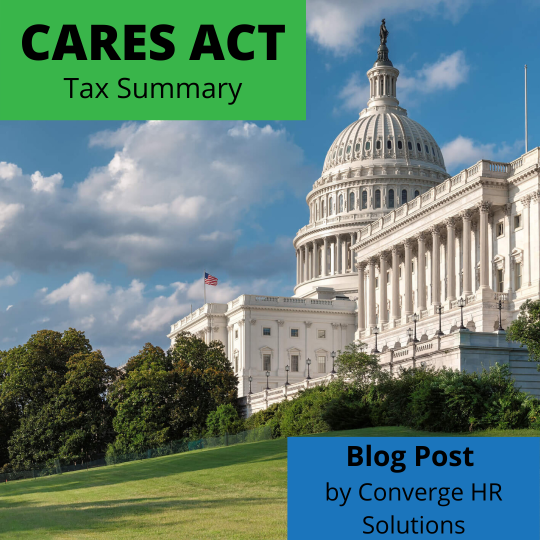
Friday, March 27th President Trump signed the
Coronavirus Aid, Relief, and Economic Security Act (CARES). The CARES Act’s $2+
trillion price tag includes extraordinary public health spending to battle the
COVID-19 pandemic, immediate cash relief for individual citizens; a broad
lending program for small businesses; and, targeted relief for industries hit
especially hard. The bill is 880 pages, and this post will summarize the
important changes to business taxes.
Business Tax Relief
The CARES Act provides assistance to businesses
through the modification of rules related to net operating losses (NOLs),
interest expense deductions, alternative minimum tax credits, and trade or
business losses of non-corporate taxpayers. These modifications are designed to
provide critical cash flow and liquidity to businesses during this COVID-19
emergency, through amending prior tax returns to obtain tax refunds. You, as an
employer, now have several new tools to help with cash flow, claiming tax
refunds, and reducing upcoming tax payments.
Employee Retention Credits
Under CARES, employers may be eligible for a
refundable tax credit for the employer’s share of the 6.2% Social Security tax
(the SSI Tax Credit). The potential SSI Tax credit is for 50% of the first
$10,000 in qualified wages (including health plan expenses) paid to each
employee commencing March 13, 2020. To be eligible an employer must (i) have
operations partially or fully suspended because of a shut-down order from a
government authority (related to COVID-19), or (ii) have had gross receipts
decline by more than 50% in a calendar quarter when compared to the same
quarter in 2019 (and will remain eligible under the earlier of (i) gross
receipts exceeding 80% relative to the same quarter in the prior year, or (ii)
December 31st, 2020). For employers with more than 100 employees (based on 2019
employment levels), qualified wages are limited to wages paid to employees who
were not providing services due to the COVID-19 crisis. It is important to note
that the SSI Tax Credit is not available if the employer received a covered
loan from the Forgivable SBA Loan program. Read more about the SBA Loan program
here.
Payroll Tax Deferral
In addition to a potential receipt of the SSI
Tax Credit, CARES allows employers to defer payment of the employer’s share of
the 6.2% Social Security tax on wages being paid beginning on March 27st 2020
and ending on December 31st, 2020. Further, a corresponding deferral is also
permitted for the equivalent portion of the self-employment taxes. The deferred
amounts are payable in two installments, with the first 50% being due December
31st, 2021, and the remainder on December 31st, 2022. This is not permitted
where an employer has had a covered loan forgiven, such as under the Forgivable
SBA Loan program.
Net Operating Loss
The 2017 tax reform bill had changed the
treatment of NOLs. The CARES Act, however, relaxes these limitations on
corporations’ use of the NOLs. Businesses are now able to carry back NOLs
incurred in 2018, 2019, and 2020 for five years (excluding the offset to
untaxed foreign earnings transaction tax). Previously the NOLs could only be
carried forward. This is significant for businesses that have the ability to
carry back NOLs to offset income that was taxed at 35% before the 2017 tax
reform. Additionally, for taxable years beginning prior to January 1, 2021,
taxpayers can offset 100% of taxable income with NOL carryovers and carrybacks
(instead of the former limit of 80% of taxable income). If there are refunds
available by the operation of these new rules, corporations can use the IRS’s
quick refund procedures (Form 1139) to claim the refund.
Business Interest Deductions
Also under the 2017 tax reform, was a bill which
introduced the new IRC Section 163(j), which limited the amount of interest
that could be deducted by most taxpayers in a taxable year to 30% of the
“adjusted tax income” (ATI) of such a taxpayer for such taxable year. For tax
years before 2022, ATI is computed in a manner similar to EBITDA. For 2019 and
2020 tax years, taxpayers may elect to increase this limit on allowable
business interest deductions from 30% to 50% of ATI. Further, taxpayers can
elect to use their ATI in 2019 in place of their 2020 ATI for purposes of
determining the destructibility of their business interest expenses for 2020
(which could increase the business interest deduction). It is important to note
that partnerships are subject to special provisions, which intend to allow
businesses to increase liquidity with a reduced cost of capital (so businesses
are able to continue operations and keep employees on the payroll.
Suspension of Non-Corporate Loss Limitation
The IRC Section 461(l) under the 2017 tax reform
bill, which disallowed the deduction of “excess business losses” by a
non-corporate taxpayer, has been removed by CARES for 2018-2020. The reform
will instead apply for 2021-2026.
AMT Credits
The 2017 tax reform repealed the corporate
Alternative Minimum Tax (AMT) credits. Corporate AMT credits were available to
corporate taxpayers as refundable credits over several years, ending in 2021.
Now CARES accelerates a corporate taxpayer’s ability to recover AMT credits,
which will allow the corporation to claim a refund by amending the
corporation’s tax returns for 2018, and 2019.
For specific details on each policy read the
full act here


0 Comments